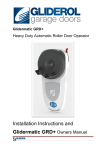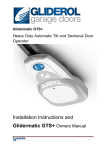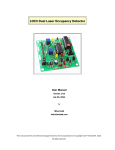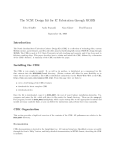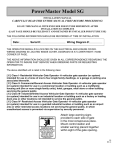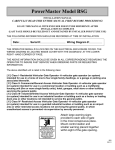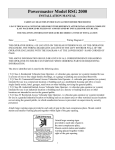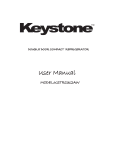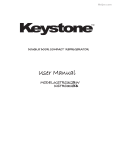Download Industrial Door Automated Installation Instructions
Transcript
Glidermatic™ Commercial Door Operator Glidermatic™ Commercial Door Operator Important Safety Instructions • DO NOT operate unless the door is completely visible and clear of obstructions including children, persons, vehicles or other objects. SEVERE PERSONAL INJURY, property damage or even DEATH may result if this warning is not followed • DO NOT operate the door if children or persons are near the opening. Children must always be supervised when near the door at all times the operator is in use • DO NOT allow children to operate the door. SEVERE PERSONAL INJURY, property damage or even DEATH may result if this warning is not followed. • The SAFETY REVERSING function should be tested on a monthly basis to ensure it is set correctly and the door will reverse on its downward motion when an obstruction is encountered. If this function does not operate DISCONTINUE USE and contact a qualified service technician. • If additional SAFETY is required, it is STRONGLY recommended that a Photo Electric Cell or Sensing Edge device be installed. It is mandatory that such devices be used in conjunction with radio control units or when momentary contact on close function is enabled. • When the Automatic Close function or Radio Transmitters are being used, a Sensing Edge or Photo Electric Cell must be correctly fitted and tested on a regular basis. If SAFETY features do not operate correctly, DISCONTINUE USE and contact a qualified service technician. • When possible activate the manual release only when the door is closed. Weak or broken springs may allow the door to fall rapidly, causing SEVERE INJURY or even DEATH. In all cases stand clear of the door. In the event that the door appears to fall, a qualified service technician will be required to adjust the spring tension. • Install the control unit on the same side of the door as the drive unit with an uninterrupted view of the door and opening. The control unit should be installed in a suitable location to ensure it is protected from the elements. Under NO CIRCUMSTANCES should the unit be exposed to water. • When installing the operator on an existing door, ensure it is good operating order. Ensure the springs are not weak or broken and the door is free of sticking or binding. Contact a qualified service technician for attention to any of these issues. • If any wiring is damaged, it MUST BE replaced by a qualified service technician in accordance with the NATIONAL ELECTRIC CODE and the manufacturers detail. • Ensure the door is completely open before proceeding through the doorway. User Manual 01 Glidermatic™ Commercial Door Operator Drive Unit Exploded Parts Diagram 1. 2. 3. 4. 5. 6. 7. 8. 9. 10. 11. 12. 13. 14. 15. Low voltage DC motors Main drive gear Geared chain wheel Drum wheel Open and close limit switches Cam Gears Manual release lever Emergency chain hoist Chain guide Drive unit plate Adaptor Slip ring bush Manual release switch Anchor bracket Cam cover 3 4 1 2 6 5 11 15 13 10 14 8 13 9 7 This manual refers to settings and connections to be performed on the DRIVE UNIT and CONTROL UNIT, not the installation of the door User Manual 02 Glidermatic™ Commercial Door Operator Control Unit The CONTROL UNIT is best mounted on the same side as the drive unit with an uninterrupted view of the door It is essential that the CONTROL UNIT be securely fixed to the wall or structure involved through the four mounting holes provided Connect the CONTROL UNIT to a 115-volt single phase AC power source, ensuring to follow local wiring codes, or National Electric Code where applicable. Suitable rigid conduit should be used to protect all wiring, and be securely fixed. Ensure the unit is properly grounded using the grounding post (green lead) in the splice connection area. Splice connection area Connect control pendant to terminal J1 Access wiring through strain relief bushing fitted Hole for mains power 115VAC Connect to drive unit wiring to terminal J6. Access wiring through strain relief bushing fitted Mounting Holes Pendant J1 Circuit breaker J6 Strain Relief Bushing CAUTION: Attach the WARNING PLACARD adjacent to the control unit User Manual 03 Glidermatic™ Commercial Door Operator Handing of the Operator (Check Setting) The Glidermatic Operator may be fitted to either the left hand or right hand side of the door, viewed from the inside looking outward. However all units as standard factory issue are configured to Right Hand operation. If required the direction of operation can be changed by setting jumper JP6 CAUTION: Always disconnect power to unit BEFORE making these setting changes. 1. Set jumper JP6 according to whether the operator is installed for Right Hand or Left Hand operation 2. For Right Hand operation (RH) ensure the jumper is set according diagram JP6 L/H R/H DRIVE 3. For Left Hand operation (LH) ensure the jumper is set according to diagram JP6 L/H R/H DRIVE User Manual 04 Glidermatic™ Commercial Door Operator Manual Operation In the event of power failure or situations where manual operation of the door is required. Manual operation is activated by use of the manual release lever. Manual Release Lever Electric Operation Manual Operation When normal operation is required, return the lever to the Electric Operation position. Engage the spring loaded release pin by carefully moving the door in either direction until pin engagement is noted and the unit is locked in position WARNING: When possible activate the manual release only when the door is closed. Weak or broken springs may allow the door to fall rapidly, causing severe injury or even death. In all cases stand clear of the door. In the event that the door appears to fall a qualified service technician will be required to adjust the spring tension User Manual 05 Glidermatic™ Commercial Door Operator Door Travel Adjustment The door travel is determined by rotation of cams in the drive unit. The cams are driven by a gear mechanism and activate a limit switch at the desired position. • The inner cam determines the closed position. • The outer cam determines the open position. To adjust • Set door to manual operation using the manual release lever (Refer to Manual Operation) • Remove the cam gear cover on the drive unit to gain access to the internal cams • Loosen cam gear screws (x3) Closing - inner cam • To set the closing position, manually lower the door to the required closed position observing the direction of rotation of the inner most cam • Rotate the inner cam in the direction observed until it activates the inner limit switch Opening - outer cam • To set the opening height, manually raise the door to the desired open position (ensure the bottom bar is short of contacting the head stop), observing the direction of rotation of the outer cam • Rotate the outer cam in the direction observed until it activates the outer limit switch To complete • Tighten the cam gear screws (x3) • Return manual release lever to normal position • Carefully move the door in either direction until pin engagement is noted and the unit is locked into position (Refer to Manual Operation) Care should be taken to ensure the lever arms on the limit switch are not obstructed by the rotation of the gearing. CAUTION: The motorised travel of the door is directly controlled by the Cam adjustment settings. Please ensure the required door travel is correctly set. User Manual 06 Glidermatic™ Commercial Door Operator Push Button Operation All control units as standard issue are configured to operate with push button operation featuring momentary contact on open and constant contact on closing, as such: UP A single press will operate the door in the upward direction. DOWN Continuous pressure needs to be applied to the down button to drive the door downward (Hold to run). Releasing this button will stop the door. STOP/RESET CAUTION: Pressing this button will STOP the door Always disconnect power to unit BEFORE making any setting changes. Momentary Contact on Close It is possible to convert the push button operation to Momentary Contact on Close from Constant Contact on Close. This will enable a single press of the button to close the door. To enable this, move jumper on JP4 Latch terminal from OFF to ON When enabling momentary contact closing operation it is essential that a supplementary safety device such as a sensing edge or Photo Electric cell be fitted to prevent injury or entrapment User Manual 07 Glidermatic™ Commercial Door Operator Safety Reversing An inherent safety feature of the Glidermatic operator is the overload function. This ensures that a closing door will stop and reverse it’s motion if an obstruction is encountered CAUTION: Always disconnect power to unit BEFORE making any setting changes. Torque Setting The Glidermatic operator is designed to stop and reverse it’s downward operation if it encounters an obstruction. This is set by adjusting JP1 to the lowest current that will allow the door to close during normal operation. Start by testing with the jumper JP1 set at 4. If the door will not close, proceed testing with JP1 set at 3 Continue setting JP1 until the door will completely close by moving the jumper accordingly. The current settings are: 1. 5.5 amps (largest door) 2. 4.5 amps 3. 3.5 amps 4. 2.5 amps (smallest door) The overload function should be tested on a regular monthly basis to ensure the door will reverse on its downward motion when an obstruction is encountered. If this function does not operate discontinue use and contact a qualified service technician. User Manual 08 Glidermatic™ Commercial Door Operator Photo Electric Cell Wiring Consult the installation instructions supplied by manufacturer of the Photo Electric Cell and determine whether the contacts are normally open (N/O) or normally closed (N/C). N/C Connect the two wires from the Photo Electric Cell receiver output terminals to the terminals marked PCELL on wiring terminal J5. OFF Always disconnect power to unit BEFORE making any setting changes. N/O CAUTION: OFF N/O N/C MOVE If the Photo Electric Cell output uses normally open contacts, move jumper on JP5 from OFF to N/O. OFF If the Photo Electric Cell output terminals feature normally closed contacts, move jumper on JP5 from OFF to N/C. N/O N/C TO TO Photo Electric Cells are recommended as a supplementary safety system. User Manual 09 Glidermatic™ Commercial Door Operator Sensing Edge Wiring Consult the installation instructions supplied by manufacturer of the Sensing Edge device and determine whether the contacts are normally open (N/O) or normally closed (N/C) . N/C Connect the two wires from the Sensing Edge terminals marked EDGE on terminal block J5. OFF Always disconnect power to unit BEFORE making any setting changes. N/O CAUTION: OFF N/O N/C MOVE If the Sensing Edge contacts are normally open, move jumper on JP3 from OFF to N/O. OFF If the Sensing Edge features normally closed contacts, move jumper on JP3 from OFF to N/C. N/O N/C TO TO Sensing Edge devices are recommended as a supplementary safety system. User Manual 10 Glidermatic™ Commercial Door Operator Radio Control Wiring In order to operate the door with a wireless remote, an independent Radio control unit may be installed and connected to the Glidermatic control unit. CAUTION: Always disconnect power to unit BEFORE making any setting changes. Power to the receiver is supplied from terminals 5 & 6 of J3 5 is +ve, 6 is ground Ensure Jumper JP2 is configured to match required voltage of radio control receiver. (5, 12 or 24VDC) Single Output Type Receiver Connect output of receiver to terminal 4 of J3 Open/Close/Stop Type Receiver Connect terminals Up Down and Stop of Radio Control Receiver to 1,2 & 3 respectively Ensure the jumper JP4 Latch terminal is set to ON Edge jumper JP3 is set to N/O Pcell jumper JP3 is set to N/O It is essential that a supplementary safety device such as a Sensing Edge or Photo Electric Cell be fitted when radio control unit is fitted to prevent injury or entrapment Consult the installation instructions supplied by the manufacturer of the radio control unit being installed for further detail including the coding of hand transmitters User Manual 11 Glidermatic™ Commercial Door Operator Radio Control Wiring There are several popular Radio control units that may be connected to the Glidermatic control unit. The wiring configuration for some of these units is highlighted below. 3 4 2 5 6 1 3 4 2 5 6 1 4 5 3 6 2 1 4 5 3 6 2 1 User Manual 12 Glidermatic™ Commercial Door Operator Automatic Close Function The Glidermatic operator can be configured to automatically close the door after a prescribed period of time up to 12 minutes CAUTION: Always disconnect power to unit BEFORE making any setting changes. Enable Automatic Close (JP4) To enable the Automatic Close Function, move Jumper on JP4 A/C terminal from OFF to ON Adjust timer Timer can be adjusted using the potentiometer A/CLOSE to achieve a maximum time delay of 12 minutes It is essential that a supplementary safety device such as a Sensing Edge or Photo Electric Cell be fitted when the automatic close function is in use to prevent injury or entrapment User Manual 13 Glidermatic™ Commercial Door Operator Alarm Function The Glidermatic operator can be connected to a security system to activate an alarm when an attempt is made to open a closed door. CAUTION: Always disconnect power to unit BEFORE making any setting changes. Alarm Wiring A 5 volt DC signal is sent to terminal J4 in the event an attempt is made to force the door open. This must drive a 5VDC relay to control any alarm fitted. Consult the installation instructions supplied by the manufacturer of the alarm being fitted for connection and relay details User Manual 14















